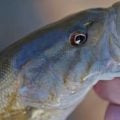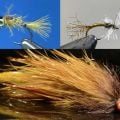How to Tie a Blue Quill Variant
Producer: Tim Flagler
I recently got to spend some time on the hallowed waters of Spruce Creek, Pennsylvania with old friend and fly fishing mentor Phil Gay. He’s the one guiding in this shot. When we arrived, conditions were beautiful for late fall and Phil was quick to realize fish were coming up in response to a modest blue quill hatch. Yes, there are some that hatch in the fall, not just in early spring.
The following morning found Phil tying a really cool, wingless blue quill variant at the breakfast table. It’s one of those patterns that has everything it needs but nothing it doesn’t. Phil ended up tying a bunch in size 16 and 18 – both sizes seemed to work well, even when fish weren’t actively rising.
Phil’s tying sequence is a little different than mine but I think the end result is very similar. His hackle is a fair bit lighter in color and has more of a tan tint to it than mine does. So here it is, a super simple and effective Blue Quill Variant – only two materials, not including tying thread.
For a hook, I’m going to use a Fulling Mill 5050 Ultimate Dry with a black nickel finish, in size 16. Begin by getting the hook firmly secured in the jaws of your tying vise. I really like how more modern barbless hooks like this, look in older, more traditional patterns. The contrast just works.
For thread, going small helps to keep bulk down, so here I’ve loaded a bobbin with a spool of brown Veevus 16/0. Get the thread started on the hook shank leaving an eye-length space behind the eye. Make sure to leave a tag that extends back from the hook at least four inches. When you reach the hook bend with thread wraps, resist that ever-so-strong urge to cut the excess tag off.
The tail and hackle for this fly come from the same medium dun cape. This is the vintage one Phil Gay used, its color is just spectacular. Although I do have a fairly close match, I really like Phil’s better. For the tailing material, I’ve plucked one of the larger feathers from the outside edge of the cape, with reasonably long, stiff, straight fibers. Pull a half dozen or so fibers down, perpendicular to the stem and, while holding their tips, pull the stem away to strip the fibers free.
Measure to form a tail a full hook in length, then transfer that measurement rearward to the start of the hook bend. Using the hook as a brace for your tying scissors, snip the butt ends off at the initial thread tie-in point. Place the fibers on top of the hook shank and take thread wraps to secure them. Apparently I could use a little moisturizer. Continue binding the hackle fibers to the top of the hook shank, almost all the way back up to that initial thread tie-in point.
Natural ring-necked pheasant tail fibers are used to create the body of the fly. Preen down 4 or 5 fibers perpendicular to the stem, then pull the feather away to strip them free. It’s always a good idea to snip off the little curlies so they don’t get caught on your tying thread and the like. While keeping the tips aligned, flip the fibers around so you’re holding them in the fingers of your left hand. Once again, use the hook as a brace for your scissors and snip just the brittle tips off square.
Give your bobbin a gentle counterclockwise spin so the first wrap of tying thread will want to jump rearward and catch those snipped off ends. Bind the fibers to the top of the hook shank, all the way back to the base of the tail. Leave your thread right there and start taking touching wraps with the pheasant tail fibers up the hook shank but behind your tying thread. This will help keep the fibers sandwiched together as you wrap. The wrapped fibers should form a good-looking, lightly tapered body on the fly. When you reach the initial tie-in point, take a few more wraps of tying thread to firmly anchor the pheasant tail, then reach in with your scissors and snip the excess butt ends off close.
Get hold of that extra-long thread tag with either your fingers or hackle pliers, and begin making open spiral counter wraps with it over top of the pheasant tail body. These wraps will markedly increase the fly’s durability. Secure the tag with wraps of tying thread then snip the excess off close.
Go back to that same hackle cape you used for the tail and this time look for a feather with fibers appropriate in length for the hook size. This one looks to be a perfect size 16. Only when I’ve determined that the feather has fibers of the correct size will I pluck it free from the cape.
To prep the feather for tie-in, snip the stem off to get rid of any lower, webby and fuzzy fibers. Preen down 8-10 fibers on both sides of the stem and snip them into a little Christmas tree shape to form a tie-in anchor. You certainly want the anchor to have a good bit of grip, but it’s also important to keep it rather short, like so.
Lay the tie-in anchor against the near side of the hook and take nice, tight thread wraps to secure it. End with your tying thread not quite at the back edge of the hook eye. Get hold of the feather’s tip with your fingers or hackle pliers, and begin making touching wraps with it up the hook shank, 4 or 5 turns should be plenty. When you reach your tying thread, use it to anchor the tip then reach in with your tying scissors and snip the excess off close.
Carefully sweep the fibers rearward and take a few more thread wraps to hold them back. If any avoided the sweep, snip them off nice and close. Now, pick up your whip finish tool and use it to do a 4 or 5 turn whip finish, seat the knot well and snip or cut your tying thread free.
A drop of head cement, here Sally Hansen Hard As Nails, applied to the thread wraps and allowed to sink in and dry will ensure they don’t come unraveled with use.
And that’s it. A super simple, yet attractive and effective Blue Quill Variant, ready to fish.
How to Tie a Blue Quill Parachute
How to Tie a Blue-Winged Olive Quill Nymph











